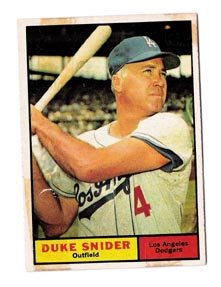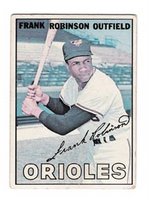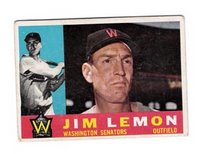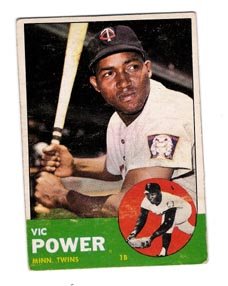 Last week, as I lazily moved from one destination to the next around Northern Vermont, I got to thinking: did Topps create Mickey Mantle, or did The Mick create Topps? (In the public consciousness, I mean). And if the former is true, couldn’t it also be said that Topps either created to help to mold the popularity (and possibly career) swings of every other baseball player since 1951? These questions got me (in a roundabout way) to the idea of the Topps checklist, the meritocracy theory behind each set’s checklist, and whether or not it would be possible—based on a few studious hours with an old Beckett and Microsoft Excel—for me to create a checklist for an ‘average’ Topps set.
Last week, as I lazily moved from one destination to the next around Northern Vermont, I got to thinking: did Topps create Mickey Mantle, or did The Mick create Topps? (In the public consciousness, I mean). And if the former is true, couldn’t it also be said that Topps either created to help to mold the popularity (and possibly career) swings of every other baseball player since 1951? These questions got me (in a roundabout way) to the idea of the Topps checklist, the meritocracy theory behind each set’s checklist, and whether or not it would be possible—based on a few studious hours with an old Beckett and Microsoft Excel—for me to create a checklist for an ‘average’ Topps set.The more I thought about it, the easier it seemed to be. So this weekend, after I got back from my trip, I started. I decided to create a checklist for an ‘average’ 1960s Topps set: 598 cards complete with 12 multi-player League Leaders, 20 All-Stars, Team Cards, Special Cards and regular cards of most players with cards in three or more sets from the decade.

I started with the biggest names first (I naively thought this would be easiest): Mantle, Mays, Aaron, Koufax, Musial, Spahn, Clemente and Frank Robinson. Mays and Aaron were the easiest of these first eight. Mays was a consistent Hero Number (full hundred numbers, like 100, 200, etc.) for most of the decade (only in 1969 was he demoted to #190, a 2nd Tier Number (like 10, 20, 540, etc., though not numbers ending in 50, which are essentially Hero Numbers), with 4 years at a number ending in 50, with two years as 200 and two years in a row as 300. I gave him #150 (Koufax took #200).
Aaron was all over the map in the Topps Sixties, with four years as a 2nd Tier, one year as a 3rd Tier (numbers ending in 5) and the remaining five years a Hero Number. It was easy for me to put him at #300.
Clemente was also easy. It took Topps quite a while to acknowledge him worthy of a Hero Number (1966, #300), so because the purpose of this exercise is to create an ‘average’ set, Clemente was not given a Hero Number, but instead a 2nd Tier, #160.
 Spahn and Koufax are interesting, because if you study the checklists from the Topps Sixties, it seems as though Koufax was Spahn’s heir to the Pitcher Hero Number—not Bob Gibson, who was just as deserving. Spahn and Koufax both had three years as a Hero Number, with Koufax ending his career as #100 in the 1966 set (Spahn ended his as #205, a 3rd Tier, in 1965). I gave Koufax #200 because it seems like Topps was positioning him to be the next full-set hero (to take over for the bad-kneed Mantle). Instead, Koufax retired and Topps elevated Gibson and Frank Robinson to take The Mick’s place. Spahn I gave #450.
Spahn and Koufax are interesting, because if you study the checklists from the Topps Sixties, it seems as though Koufax was Spahn’s heir to the Pitcher Hero Number—not Bob Gibson, who was just as deserving. Spahn and Koufax both had three years as a Hero Number, with Koufax ending his career as #100 in the 1966 set (Spahn ended his as #205, a 3rd Tier, in 1965). I gave Koufax #200 because it seems like Topps was positioning him to be the next full-set hero (to take over for the bad-kneed Mantle). Instead, Koufax retired and Topps elevated Gibson and Frank Robinson to take The Mick’s place. Spahn I gave #450.It got interesting with Mantle, Musial and Robinson, and my decision came down to the two central ideas of my take on the Topps Numbering System: statistical superiority and institutional hero worship.

Stan Musial was in the twilight of his career in the Sixties: good, not great, he didn’t play every day;,that kind of thing. Happens all the time with players, and had he played in the 1980s and 1990s, he probably would’ve ended up with a career either like Cal Ripken (one team forever with lots of money) or like Eddie Murray: twenty-some odd years with one team and then following the money to a chain of other teams before retirement. But this isn’t the point. The point is that Topps rewarded Musial with two out of his final four years at #250 (including 1963, his last). That is some Hero Worship right there. Did he deserve #250? Probably not statistically, but in the hierarchy of the Topps Numbering System, Hero Worship beats Statistics any day of the week. So then it was obvious for me to slot Musial in at #250.
Musial proved to be just a prelude to the biggest idea of them all: should I reward Mickey Mantle Statistically or should I reward him with Hero Worship? What would Topps have done? There’s no question he deserved both, but then so did Frank Robinson, as Robinson won 2 MVPs (one in each league), won a World Series with the O’s in 1966 and was undoubtedly one of the most consistent super stars of the decade. Robinson was a Hero Number five years in the Sixties, and five years a 2nd Tier.
Topps gave Mantle a Hero Number every year except 1968 (#280), capping him at #500 in his last year, 1969. Topps featured Mantle on at least 29 different cards during the Sixties, more than any other player.
Both deserved Hero Numbers, and the two most logical open slots were #350 and #500. I ended up giving Robinson #350 and Mantle #500 because I reasoned that while #350 is almost the middle of the set, with more exposure during the pack-buying and set-building year, #500 was the Sixties Hero Worship card (like #1 was to Ted Williams in the Topps Fifties). Topps gave it to Mantle in his last year—never before. (Incidentally, Frank Robinson was #500 in 1968, even though perhaps it should have been Carl Yastzremski, winner of the 1967 AL Triple Crown (instead, Yaz got #250, his only Hero Number card in the decade).) Robinson was the statistical powerhouse of the decade, so it followed that he should get the Statistical Hero Number (#350).
After these first eight, I had a pretty good handle and could identify most of the rules and quirks of a system like this:
Levels of Numbering:
1. Hero Worship (generally one card per set, usually #500)
2. Hero Number (1, 50, 100, 150 , … etc.)
3. 2nd Tier Number (10, 20, 30, 40, 60, … etc.)
4. 3rd Tier Number (5, 15, 25, 35, 45, 55, … etc.)
5. Rookies & Late Bloomers (Common Level numbers of non-established future stars)
6. Common Level Numbers (all the other numbers)
 Other Things to keep in mind:
Other Things to keep in mind:1. No players from the same team within 7 numbers of each other
2. No players with less than three years of cards in the decade (there will be notable exceptions)
3. All-Stars based on number of inclusions across the decade
4. No expansion teams (or very few cards of expansion teams)
5. No favoritism (besides Institutional Hero Worship)
A good example of ‘No Favoritism’ is the case of Lou Brock. Look at Brock’s number for the decade:
1962 (rookie) #387
1963 #472
1964 # 29
1965 #540
1966 #125
1967 #285
1968 #520
1969 # 85
Generally it took Topps about 3 years to give a worthy player a Tiered Number. Brock was no exception, and I’m not trying to suggest that I think he was worthy of a Hero Number—he most certainly wasn’t. But I gave him #285 (3rd Tier) because of his eight cards, three were 3rd Tier; it was the most accurate thing to do. If it were up to me, I would’ve put him higher up, probably a mid-500 2nd Tier.
Now that I get deeper and deeper into this, I’m beginning to realize how long it will take to get even an ‘average’ set like this right. I’ve only just gotten my feet wet, so far as identifying and numbering 27 individual players. I will post updates as I go, finally ending with a complete 598-card checklist.
Here’s what I’ve got so far:
#20 Ernie Banks, Cubs
#30 Eddie Mathews, Braves
#65 Nellie Fox, White Sox
#70 Harmon Killebrew, Twins
#80 Richie Allen, Phillies
#90 Luis Aparicio, White Sox
#107 Rusty Staub (one of those Late Bloomer/Future Stars), Astros
#120 Pete Rose, Reds
#150 Willie Mays, Giants
#155 Roger Maris, Yankees
#160 Roberto Clemente, Pirates
#195 Joe Morgan, Astros
#200 Sandy Koufax, Dodgers
#225 Carl Yastzremski, Red Sox
#250 Stan Musial, Cardinals
#260 Don Drysdale, Dodgers
#285 Lou Brock, Cardinals
#300 Hank Aaron, Braves
#320 Bob Gibson, Cardinals
#330 Rocky Colavito, Indians
#350 Frank Robinson, Orioles
#410 Al Kaline, Tigers
#450 Warren Spahn, Braves
#470 Willie McCovey, Giants
#480 Yogi Berra, Yankees player/coach
#500 Mickey Mantle, Yankees
#510 Rod Carew, Twins
 If anyone has an idea for what the design of this average Topps 1960s set would look like, send it to me by email and I’ll post the best three. I’d like to see fronts and backs, as well as League Leaders and All-Star card designs.
If anyone has an idea for what the design of this average Topps 1960s set would look like, send it to me by email and I’ll post the best three. I’d like to see fronts and backs, as well as League Leaders and All-Star card designs. If ever you’ve wanted to design a baseball card and have it seen by people who care about baseball cards, this is a chance to show your idea. Just remember, designs should be able to fit well with the other sets from the Topps Sixties.

No comments:
Post a Comment